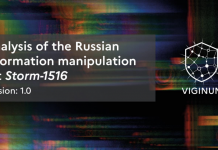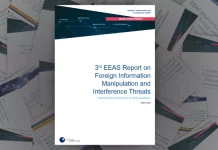Pro-Russian disinformation, local elections and the COVID-19 epidemic were the strongest factors influenced Ukrainians’ media consumption and their communications on social media networks in 2020. Detector Media conducted a large-scale study using classical media monitoring, expert interviews, big data analysis and sociological research in order to get detailed answers to several key questions: 1) who and what influenced the perception of information and the effectiveness of disinformation in Ukraine in 2020; 2) what kind of actors were trying to manipulate Ukrainian society at the national level, and in the South and East of Ukraine in particular; and 3) how Ukrainians responded to the main events and challenges of 2020. This is an analytical report on the results of that study.
Contents
- Problem statement
- Methodology
- Research terminology
- How do residents of the southern and eastern regions of Ukraine consume information?
- Pro-Russian disinformation narratives
- Disinformation related to the coronavirus epidemic
- Disinformation related to the local elections in Ukraine
- What do people in the regions care about?
- Who are the most influential actors in Ukrainian social media networks?
- Assessment of vulnerability and resilience of residents of southern and eastern regions of Ukraine
- Summary
- Key conclusions
- Recommendations
Problem statement
People all around the world spent a lot of time in front of screens in 2020, and Ukrainians were no exception. The COVID-19 pandemic has restricted physical mobility, cancelled plans and literally kept everyone in their homes. This development has been a challenge, since humans are social beings. The need for security encourages people to take membership in communities, especially in times of uncertainty like the coronavirus pandemic. If you define yourself as part of a certain community, you believe that this community will be able to protect you and your family, through a common future and a common solution to problems.
A person’s perception of their surrounding reality shapes their behaviour and dictates everyday decisions. A person adjusts their behaviour in accordance with the requirements of the community by, for example, adhering to the general point of view of that community accordingly forming a vision of the future. The main source of information by which this vision and worldview is formed and aligned with the communities one identifies with is the media (classical, new and social media).
Since the beginning of the pandemic, people around the world have begun to spend more time online. Global Internet traffic was up 30% from 2019 by July. More time in front of screens means more consuming and creating the content. Media consumption and online user behaviour largely reflect societies’ real moods. Posts, likes, comments and retweets serve as a mirror of users’ reactions to events. On the other hand, social platforms and stakeholders often influence these reactions. Theoretically, the responsible consumption of information, critical thinking, and the objective reflection of reality by journalists give a person the ability to choose between different communities and different visions of the future. In practice, however, stakeholder groups often influence or even shape information ecosystems which fragment society by dictating certain realities that these groups find more beneficial. For example, according to the Oxford Internet Institute, back in 2018, 48 countries experienced manipulative information campaigns on social networks during their elections.
The desire to influence the masses, in particular through disinformation and misinformation, is not a new phenomenon, but it poses new and hard challenges to the democratic world as technology has revolutionized the sharing of information. Ukraine suffers from Russia’s hybrid aggression, which makes monitoring the Ukrainian information environment, understanding the players trying to shape the agenda, and tracking citizens’ reactions crucial to reforming and building the country’s democratic society. Detector Media decided to focus its attention on the South and East of Ukraine, whose oblast border the illegally Russian-occupied Donbas and Crimea. The region is marked by ethnic and cultural diversity and, of course, proximity to Russia, both territorially and ideologically, as we can see by looking at electoral preferences and attitudes of the population towards Ukraine’s foreign policy.
Ukraine has been facing Russian and pro-Russian information aggression for a long period. Illegal annexation of Crimea followed by military aggression on Donbas are considered as one of the scenarios that happened with the support of extensive, deteriorating disinformation campaigns. The regions of South and East Ukraine border the occupied Crimea from one side and the contact line from the other side. From the perspective of malign information operations, this region can be targeted by direct disinformation campaigns orchestrated by Russian and its domestic proxies in Ukraine. It contributes to maintaining and generating a pro-Russia, anti-Ukrainian electorate tricked into fulfilling Russia’s plans on undermining Ukraine’s independence and democratic aspirations.
This analytical study addresses the vulnerability of the South and East of Ukraine through looking at the penetration rate of hostile narratives into media space of South-East Ukraine. Two major indicators have been assessed in order to describe the problem: 1. world view of media consumers in South-East Ukraine, and 2. changing patterns of media consumption in South-East Ukraine.
The region proved to be vulnerable in terms of Russian and pro-Russian key narratives affecting citizen’s views and opinions. It affected citizens’ attitude towards Ukraine’s integration to the EU and NATO. The general population in the region has been more sceptical towards the Euro-Atlantic integration that other regions in Ukraine. Even though, the support of this geopolitical vector has been slowly growing since 2014, it has not exceeded the 50% barrier. Electoral preferences of citizens also reflect more positive attitudes towards pro-Russian rather than pro-European parties in the region. For example, results of 2020 local elections in Ukraine demonstrated some leading trends pro-Russian political forces in Odesa, Kherson, Mykolaiv and Zaporizhzhya oblasts. Those domestic actors usually mimic key disinformation narratives produced by Russia.
Since 2014, there has been a growing number of citizens in the region who cannot decide whether they agree with pro-Russian or Pro-Ukrainian interpretation of events on national significance. For instance, war on Donbas: a remarkable share of the local population either blame the Ukrainian government for starting the war or cannot affiliate responsibility for the war to any party. Other sociological indicators support analytical assumption regarding negative effects of penetrating hostile narratives on citizens’ attitudes and opinions in South-East Ukraine.
Media consumption is also an important indicator. The shifts in media consumption in the region is affected by several factors at the same time: ongoing pandemic of COVID-19, toxicity and reach of Russian and pro-Russian media channels, and labile structure of media landscape.
As demonstrated by analysis conducted by the Detector Media, most pro-Russian narratives originates from television, in particular, from the media channels controlled by pro-Russian political forces in Ukraine. Those media and TV channels enjoy the highest level of trust in South-East Ukraine. While broadcasting TV is still the king in the region, information consumption from social media networks is impressively growing. Officially banned in Ukraine, the Russian social media network VK is still popular in the region as 33% of the residents still regularly use it for getting the latest information about events in Ukraine and the world. Many groups in VK as well as channels in Telegram and YouTube are provenly considered to be a breeding ground for anti-Ukrainian rhetoric and hate speech.
The year 2020 was marked not only by the pandemic, but also by local elections in Ukraine, which significantly affected the information environment of the South and East, as well as the country as a whole. Ukraine was one of the first countries in the world to hold elections during the COVID-19 pandemic. Moreover, local elections, which became even more important in the context of Ukraine’s decentralization reforms, were conducted in accordance with a new electoral code. The complexity of Ukraine’s internal processes and Russia’s ongoing hybrid aggression have generally added obstacles to the country’s reform and democratic development process, not to mention the chaos caused by the pandemic, which has challenged even the world’s most stable democracies. These processes make it necessary to constantly monitor the information environment as a basis for decision-making, implementing reforms and communicating necessary changes to society.
Finally, media consumption in 2020 was affected by the decision of all the biggest Ukrainian TV holdings to code their satellite signal in order to develop pay TV market. The decision was made in January 2020. As a result, Ukraine entered the COVID-19 quarantine with more than 2 million households without access to the most popular Ukrainian TV channels, and with news TV channels (including “Medvedchuk group”) and Russian broadcasters instead.
This research covers period from March to November 2020 and shows the influence of the above-mentioned factors on Ukrainian media landscape and media consumption.
Methodology
As part of this study, Detector Media asked several research questions:
— How has the media landscape changed after the coding of satellite TV signals?
— How has the consumption of media content changed during the quarantine?
— What disinformation narratives were spread by local figures and the Kremlin during the election campaign?
The eight target regions of the study include Donetsk, Luhansk, Zaporizhzhia, Dnipropetrovsk, Odesa, Kherson, Mykolaiv and Kharkiv regions. In the case of Donetsk and Luhansk regions – we talk about the free, government-controlled areas of them – the media of the occupied areas were not studied (it is more difficult for social networks to make such a distinction). The South and East of Ukraine require constant monitoring and analysis in the context of information security. The region is characterized by socio-cultural diversity, which is often exploited in foreign and domestic information operations. Its geographical proximity to Russia in general and to the demarcation line in particular makes this region a target for manipulation campaigns.
In the first stage, Detector Media conducted an expert study of the media outlets (television news, talk shows, online publications, groups in social media and Telegram channels) which are the most popular in the target regions, as well as a study of media content at the national level.
In the second stage, we monitored the content of Ukrainian media, looking for disinformation and narratives:
— in local online groups and social networks posts by city residents in the target regions;
— in online publications;
— on local television channels in the target regions (evening television news on two local TV channels in each region during five work days).
In the third stage, we conducted a sociological study on the role of social platforms and oral communication, as well as on the effectiveness of disinformation narratives. This made it possible to find disinformation that digital monitoring tools did not see.
The study consists of a qualitative sociological study in the target regions, during which we collected the necessary information for the second stage – representative quantitative research in the target regions. We asked questions about the practice of using social networks, forms of verbal transmission of unverified information, etc.
In the fourth stage, we compared Ukrainian disinformation narratives found during the study with the narratives distributed in Russian media to find similarities and differences, as well as the foreign origin of some narratives.
Methodology of social network content analysis: We had SemanticForce and Let’sData collect and analyze over 23 million messages from eight target regions on Facebook, YouTube, Instagram, Twitter and Telegram. The collected material underwent cluster data analysis to identify disinformation narratives in the Ukrainian segment of the social networks, in particular those related to the socio-political life of the regions. Content and sentiment analysis was conducted within the clusters. Users within each cluster were analyzed separately; opinion leaders, trolls, and bots were identified and links among them were established.
Methodology of the sociological survey: The survey of public opinion of the residents of the target regions was conducted by the Kyiv International Institute of Sociology in November 2020 on behalf of Detector Media. Adults (18 years and older) in these regions were asked about watching TV channels, using social networks and generally accessing various sources of information, as well as about socio-political sentiments, particularly in the context of countering disinformation and propaganda. A separate representative sample was developed for each of the eight regions – a three-stage random sample with quota selection at the last stage. The sample of each region is representative for adults (18 years and older) who live permanently in the region, do not serve in the military, are not imprisoned and are not residing in hospitals or boarding schools.
The field phase of the study lasted from November 12 to December 1, 2020. 3264 interviews – 408 in each region – were conducted. The statistical error for all respondents (with a confidence level of 0.95 and without taking into account the design effect) does not exceed:
- 1.7 % for figures close to 50%,
- 1.5 % for figures close to 25 or 75%;
- 1.1 % for figures close to 12 or 88 %;
- 0.8 % for figures close to 5 or 95 %.
The statistical error of the sample of 408 respondents (each region separately) (with a confidence level of 0.95 and without taking into account the design effect) does not exceed:
- 5.0 % for figures close to 50%,
- 4.3 % for figures close to 25 or 75%;
- 3.3 % for figures close to 12 or 88 %;
- 2.2 % for figures close to 5 or 95 %.
Focus group methodology: 4 focus group interviews were conducted with a total of 33 participants, including: 16 women and 17 men; 12 people under the age of 35, 11 people aged 36 to 59 and 10 people aged over 60; 4 residents of Zaporizhzhia region, 4 residents of Kherson region, 4 residents of Mykolaiv region, 4 residents of Odesa region, 4 residents of Kharkiv region, 4 residents of Dnipropetrovsk region, 4 residents of Luhansk region and 5 residents of Donetsk region.
Expert interview methodology: A qualitative sociological survey using the method of in-depth interviews was conducted. 15 interviews were conducted as part of the survey. Participants included experts in the field of mass media, mass communications and civil society, and civil servants responsible for the information sphere.
List of interviewed experts:
Liubov Tsybulska, head of Hybrid Warfare at Ukraine Crisis Media Center
Yulia Kazdobina, ex-adviser to the Minister of Information Policy of Ukraine
Dmytro Dubov, head of the Information Security and Information Society Development Department of the National Institute for Strategic Studies;
Dmytro Zolotukhin, former Deputy Minister of Information Policy
Volodymyr Yermolenko, Analytics Director, Internews Ukraine, Editor-in-Chief at UkraineWorld.org;
Oksana Moroz, founder of the How Not to Become a Vegetable initiative
Oksana Melnychuk, head of the Cultural Policy Department at the National Institute for Strategic Studies under the President of Ukraine;
Maria Zolkina, Political Analyst at Ilko Kucheriv Democratic Initiatives Foundation;
Mykola Ozhevan, expert at the National Institute for Strategic Studies;
Tetiana Lebedeva, honorary chair of the Independent Association of Broadcasters, Fundraising Curator and Representative on the Supervisory Board; member of the Supervisory Board of the National Public Television and Radio Company of Ukraine; member of the Commission on Journalistic Ethics;
Volodymyr Borodiansky, former Minister of Culture, Youth and Sports;
Serhiy Solodkyi, First Deputy Director of the New Europe Center; expert in foreign policy, international relations and security;
Dmytro Kuleba, Minister of Foreign Affairs of Ukraine;
Gillian McCormack, director of Internews in Ukraine;
Roman Shutov, Eastern Partnership Network Manager of Open Information Partnership.
Research terminology
Propaganda is a systematic communication process that combines a series of activities to convey information, facts, and messages to the target audience in order to form a world view or impose certain values, opinions, views on specific things/phenomena/events. Propaganda is divided into “black” and “white” depending on the goals and methods it pursues. Black propaganda is destructive in nature. Disinformation campaigns and fakes are used within the framework of black propaganda. White propaganda aims to convince society of the adoption of attitudes and values; it operates with truthful information.
Disinformation is the dissemination of false information and the distortion of facts in order to influence the thoughts and behavior of individuals or a society, achieving belief by social groups in a picture of the world different from the real one.
Disinformation narratives in this study refer to stable sets of statements or assessments which, according to the authors of the study, are generally intended to influence public opinion by exaggerating or distorting the picture of reality. All the narratives on the list are typical of Russian propagandist media, so the study records statements and assessments that are consistent with them. As it is impossible to determine the motivation of journalists, media or other distributors of media content, the authors of the study do not claim that they are engaged in targeted pro-Russian propaganda, instead of, for example, simply criticizing the current government or certain political opponents. We only state the fact that messages appear in their materials which are identical or close to the Kremlin’s narratives.
A fake is an information unit that contains fictional stories, personalities, news, events, trends etc., or distorts true facts, and which is used to influence people’s opinions and behavior. A fake can be a tool to achieve the goals of a disinformation campaign.
A bot is an automated account programmed to interact with users, in particular on social networks. It is programmed to automatically perform certain actions, such as “distribute” or “comment” on a given schedule.
A troll is an account managed by a living person. In the context of disinformation, trolls emotionally color discussions, provoke other users, and sow doubt and mistrust.
Find the research results here.
This report was produced with the financial support of the European Union. Its contents are the sole responsibility of NGO Detector Media and do not necessarily reflect the views of the European Union.
Authors: Galyna Petrenko, Otar Dovzhenko, Oksana Iliuk, Petro Burkovskyi
Editor-in-chief: Natalia Ligachova





